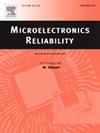Heterogeneity-induced thermal mismatch in BGA interconnects: Insights from mechanical-thermal finite element modeling
IF 1.6
4区 工程技术
Q3 ENGINEERING, ELECTRICAL & ELECTRONIC
引用次数: 0
Abstract
Thermal expansion mismatch due to the heterogeneous materials in ball grid array (BGA) interconnects of electronic packaging structures often results in localized strain concentration, leading to creep, fatigue, or potential failure. Modeling BGA solder balls independently, without considering connected and contacting components, fails to comprehensively monitor the system's state. In this study, a mechanical-thermal finite element model (FEM) comprising solder balls, a printed circuit board (PCB), chips, and underfill is systematically developed. Time-dependent nonlinear analysis is performed on Sn-Ag-Cu (SAC) solder-bumped flip chips in PCB assemblies subjected to thermal cycling. Thermal gradient contours illustrate inhomogeneous in-plane and vertical thermal diffusion within the components. The Garofalo model is employed in the FEM to simulate visco-plastic behavior. The results reveal significant thermal gradient mismatches due to the intrinsic properties of heterogeneous components, which are often overlooked in independent material studies. Additionally, the central region of the BGA exhibits more pronounced creep strain compared to edge solder balls. These findings provide valuable insights for optimizing BGA geometric design. This work also offers a comprehensive framework to quantify thermal mismatches and simulate creep behavior under thermal cycling based on FEM.
BGA互连中异质性引起的热失配:来自机械-热有限元建模的见解
电子封装结构中球栅阵列(BGA)互连中的非均质材料导致的热膨胀失配往往会导致局部应变集中,从而导致蠕变、疲劳或潜在失效。单独对BGA焊球建模,不考虑连接和接触组件,无法全面监控系统状态。在这项研究中,一个机械-热有限元模型(FEM)包括焊料球,印刷电路板(PCB),芯片,和底料系统开发。对热循环作用下PCB组件中的Sn-Ag-Cu (SAC)焊料碰撞倒装芯片进行了时间相关的非线性分析。热梯度轮廓说明了组件内不均匀的面内和垂直热扩散。有限元法采用Garofalo模型模拟粘塑性行为。结果表明,由于非均质组分的固有性质,在独立的材料研究中经常被忽视的热梯度不匹配。此外,与边缘焊料球相比,BGA的中心区域表现出更明显的蠕变应变。这些发现为优化BGA几何设计提供了有价值的见解。这项工作还提供了一个全面的框架来量化热不匹配和模拟基于FEM的热循环下的蠕变行为。
本文章由计算机程序翻译,如有差异,请以英文原文为准。
求助全文
约1分钟内获得全文
求助全文
来源期刊

Microelectronics Reliability
工程技术-工程:电子与电气
CiteScore
3.30
自引率
12.50%
发文量
342
审稿时长
68 days
期刊介绍:
Microelectronics Reliability, is dedicated to disseminating the latest research results and related information on the reliability of microelectronic devices, circuits and systems, from materials, process and manufacturing, to design, testing and operation. The coverage of the journal includes the following topics: measurement, understanding and analysis; evaluation and prediction; modelling and simulation; methodologies and mitigation. Papers which combine reliability with other important areas of microelectronics engineering, such as design, fabrication, integration, testing, and field operation will also be welcome, and practical papers reporting case studies in the field and specific application domains are particularly encouraged.
Most accepted papers will be published as Research Papers, describing significant advances and completed work. Papers reviewing important developing topics of general interest may be accepted for publication as Review Papers. Urgent communications of a more preliminary nature and short reports on completed practical work of current interest may be considered for publication as Research Notes. All contributions are subject to peer review by leading experts in the field.
 求助内容:
求助内容: 应助结果提醒方式:
应助结果提醒方式:


